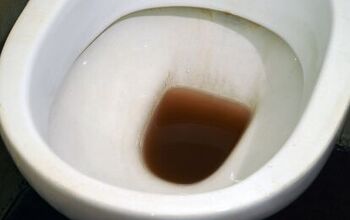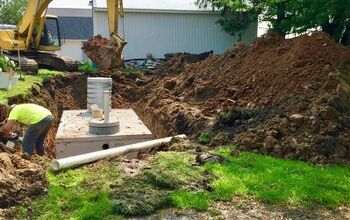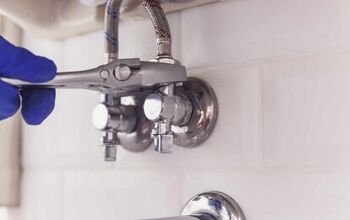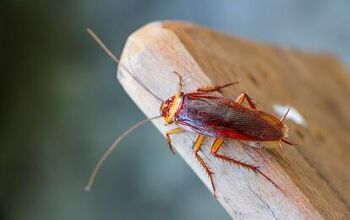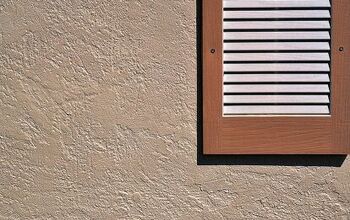Why Is My House Full Of Gnats? How To Get Rid Of Them

Nobody wants to find flying insects in their house, as they’re unnerving and even unsanitary. However, gnats and flies find their way into countless homes, much to the bewilderment of homeowners. So, why is my house full of gnats, and how do I get rid of them?
Your house is likely full of gnats because of excessive moisture and organic matter, such as food scraps and houseplant soil. Gnats commonly stay near drains, as they sense rotting food and water in the garbage disposal. You may also see a lot of gnats because your doors and windows have gaps and cracks that let bugs in.
Install weatherstripping on your doors and patch or replace your window screens to keep gnats out of your house. Follow along as we explore why your house is full of gnats and highlight how to keep them away.
Why Are There Gnats In My House?
1. Plumbing Leaks
Fungus gnats love moisture, and that’s why you often find them in and around drains and plumbing leaks. That’s especially true in kitchens where gnats can smell decaying food remnants. The mixture of food and moisture can provide gnats with a steady source of food and water.
There's a good chance that a puddle of standing water lies beneath the leaky plumbing fixture. Gnats often mate in standing water, which means your gnat problem may get worse. They will continually breed in your home unless you fix the plumbing leak and mop up the puddle.
Luckily, you can fix simple plumbing fixtures with plumber’s putty and silicone caulk. Otherwise, you must call a plumber to fix the leak and prevent the problem from worsening. Set up some simple sticky traps to catch and kill the remaining gnats after fixing the leak.
2. Excess Or Exposed Trash
All the peskiest bugs love to hang around garbage, and that’s because it means they get to eat. You won’t do yourself any favors by regularly leaving food scraps on your counter. The same can be said for leaving your trash uncovered for an extended period.
Clean up after yourself after each meal, so you don’t invite unwelcome gnats to hang around. It’s also important to keep the lid on your trash can and even tuck it away whenever possible. Regularly clean your kitchen table and countertops to ensure no food remains.
It’s also a good idea to keep your trash bin outside of your home with the lid closed. Otherwise, you may attract gnats to your garage, and they may eventually get into your house. Turn your garbage disposal on and run some water each time you clean your plates to reduce the trash in your disposal.
3. Carefully Plan Your Compost Bin
There’s nothing wrong with composting, that is, unless you place your bin too close to your house. Naturally, compost bins are full of organic matter in various stages of decomposition. That, paired with moisture and the fact that it’s outside, can easily attract tons of gnats.
However, that isn’t a problem unless your compost bin is too close to your home. Ideally, you should place your compost bin at least 15 feet away from your home. The further your compost bin is from your house, the less likely you are to have a big gnat problem.
Cover your compost bin as well as possible to keep gnats out of it. Otherwise, they will use your compost bin to feed and reproduce, which will eventually worsen the problem.
4. Door Gaps
Door gaps can invite gnats and other bugs into your house. Not only that, but door gaps can also waste money as they affect your home’s temperature and make your HVAC system work harder. For example, your air conditioner may run more frequently during summer if cool air escapes beneath the gap in your door.
You will also likely find gnats, flies, mosquitoes, and spiders in your home if your doors have gaps beneath them. Even large pests, like snakes, can sneak into your home if the gaps are big enough. You can easily get rid of gnats and other pests if you close your door gaps with weatherstripping.
Weatherstripping often costs under $10, but it varies based on the size, material, and brand. Some people even replace their problematic doors, which typically start at $200.
5. Torn Window Screens
Does your home have a screened-in porch or window screens? If so, they may have gaps, holes, and tears in them that you’re unaware of. Such tears can easily let gnats enter your home, eat, and even reproduce until the problem gets out of hand.
Your first instinct may be to replace the screens, but that may be unnecessary. In some cases, you can patch the tear with a screen patch kit, sewing patch, or window screen tape. However, you must check what kind of material your screens are made of, as that will dictate what kind of patch you need.
Otherwise, it’s a great idea to replace the screen altogether if it’s beyond repair. Re-screening a window typically costs $145 to $515, but it varies based on the size and material it’s made of. You can spend as little as $200 to re-screen several windows if you buy the screens and install them without professional help.
6. Plants
Do you have lots of plants near your home? The closer the plants are to your exterior walls, the more likely they are to attract gnats and other bugs. That’s because the moist soil and organic matter it contains can easily entice gnats.
It provides a great source of water and an opportunity for them to mate. That’s especially true if you aren’t careful when you water them. Overwatering your plants can hinder growth, wash nutrients out of the soil, and attract gnats.
Fruit-bearing plants can especially attract gnats, as they’re drawn to the sweet scent. You must be extra careful if you have houseplants. Ideally, you should only give your plants exactly how much water they need to survive. Otherwise, the soil moisture will attract gnats.
7. Exposed Pet Food
Gnats love dog and cat food as much as they love the food you wash down your kitchen drain. After all, it’s still organic matter, and gnats can easily pick up the scent. Ideally, you should store your extra dog or cat food in a large airtight bin.
This will prevent smells from getting out that would otherwise attract gnats. It’s also a great idea to dump the extra food back into the bin at night when it’s time for your pets to sleep. Keep an eye on the water bowls, as gnats may try to reproduce in them.
Yes, that’s a gross thought, but they love to mate in standing water. Regularly clean and replenish your food and water bowls and gnats and other bugs most likely land in them occasionally.
Can Gnats Bite People?
Yes, gnats can bite people, but their bites are relatively harmless in most cases. That said, you may notice skin irritation and itchiness, which can be quite annoying. Female gnats sometimes bite people and even use human blood to create eggs.
However, you shouldn’t panic if you notice a gnat bite on your skin. Simply apply a cold compress or anti-itch cream to reduce the itchy sensation. Don’t scratch your gnat bite too much, or you will irritate your skin much worse than if you left it alone.
Summing It Up
Gnats typically enter homes because they sense moisture and organic matter, such as decaying food. You may also find gnats in your home if you have houseplants and overwater them. Cover your trash, clean your counters, patch your window screens, and install weatherstripping to keep gnats out of your house.
Related Guides:

Nick Durante is a professional writer with a primary focus on home improvement. When he is not writing about home improvement or taking on projects around the house, he likes to read and create art. He is always looking towards the newest trends in home improvement.
More by Nick Durante











![How Much Weight Can a 4×4 Support Horizontally? [It Depends!]](https://cdn-fastly.upgradedhome.com/media/2023/07/31/9070333/how-much-weight-can-a-44-support-horizontally-it-depends.jpg?size=350x220)
![The 5 Best Angle Grinders – [2022 Reviews & Buyer's Guide]](https://cdn-fastly.upgradedhome.com/media/2023/07/31/9071326/the-5-best-angle-grinders-2022-reviews-buyer-s-guide.jpg?size=350x220)

